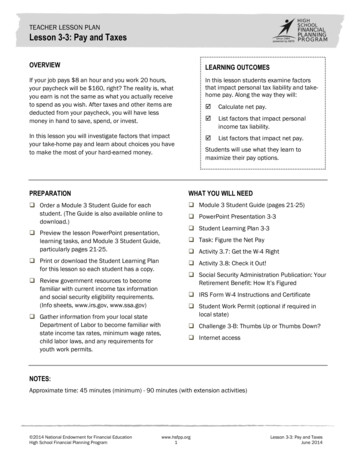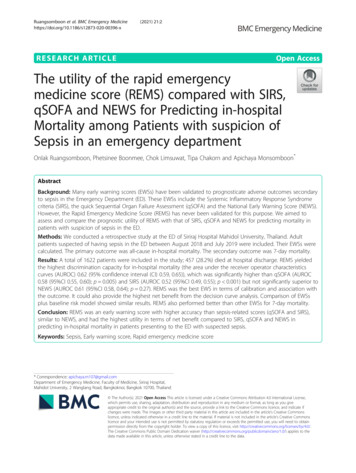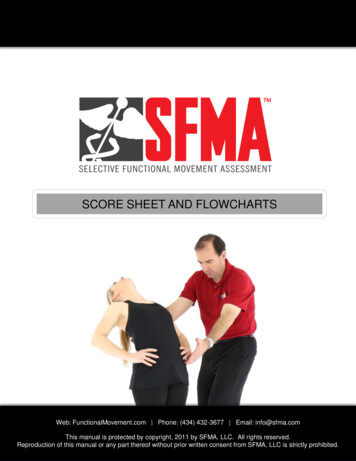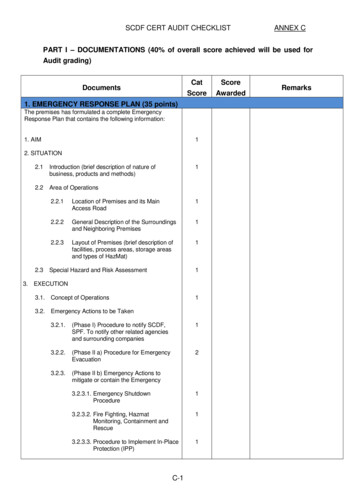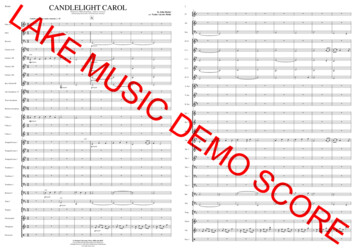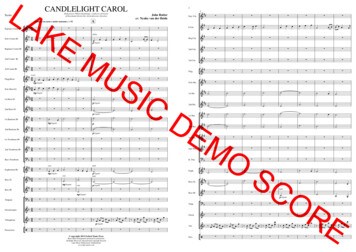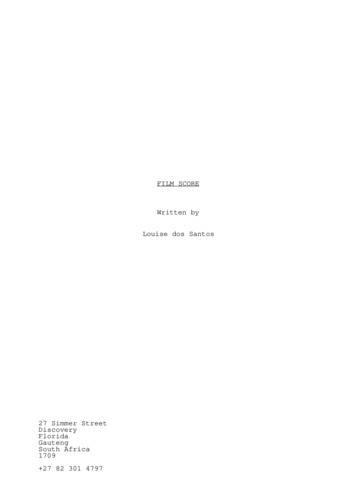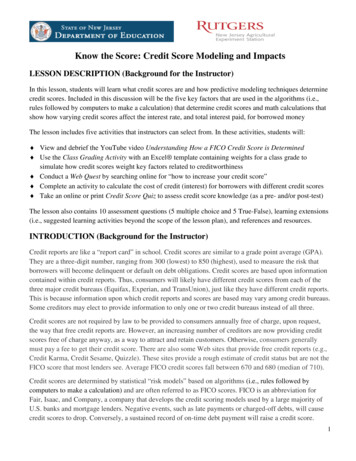
Transcription
Know the Score: Credit Score Modeling and ImpactsLESSON DESCRIPTION (Background for the Instructor)In this lesson, students will learn what credit scores are and how predictive modeling techniques determinecredit scores. Included in this discussion will be the five key factors that are used in the algorithms (i.e.,rules followed by computers to make a calculation) that determine credit scores and math calculations thatshow how varying credit scores affect the interest rate, and total interest paid, for borrowed moneyThe lesson includes five activities that instructors can select from. In these activities, students will: View and debrief the YouTube video Understanding How a FICO Credit Score is Determined Use the Class Grading Activity with an Excel template containing weights for a class grade tosimulate how credit scores weight key factors related to creditworthiness Conduct a Web Quest by searching online for “how to increase your credit score” Complete an activity to calculate the cost of credit (interest) for borrowers with different credit scores Take an online or print Credit Score Quiz to assess credit score knowledge (as a pre- and/or post-test)The lesson also contains 10 assessment questions (5 multiple choice and 5 True-False), learning extensions(i.e., suggested learning activities beyond the scope of the lesson plan), and references and resources.INTRODUCTION (Background for the Instructor)Credit reports are like a “report card” in school. Credit scores are similar to a grade point average (GPA).They are a three-digit number, ranging from 300 (lowest) to 850 (highest), used to measure the risk thatborrowers will become delinquent or default on debt obligations. Credit scores are based upon informationcontained within credit reports. Thus, consumers will likely have different credit scores from each of thethree major credit bureaus (Equifax, Experian, and TransUnion), just like they have different credit reports.This is because information upon which credit reports and scores are based may vary among credit bureaus.Some creditors may elect to provide information to only one or two credit bureaus instead of all three.Credit scores are not required by law to be provided to consumers annually free of charge, upon request,the way that free credit reports are. However, an increasing number of creditors are now providing creditscores free of charge anyway, as a way to attract and retain customers. Otherwise, consumers generallymust pay a fee to get their credit score. There are also some Web sites that provide free credit reports (e.g.,Credit Karma, Credit Sesame, Quizzle). These sites provide a rough estimate of credit status but are not theFICO score that most lenders see. Average FICO credit scores fall between 670 and 680 (median of 710).Credit scores are determined by statistical “risk models” based on algorithms (i.e., rules followed bycomputers to make a calculation) and are often referred to as FICO scores. FICO is an abbreviation forFair, Isaac, and Company, a company that develops the credit scoring models used by a large majority ofU.S. banks and mortgage lenders. Negative events, such as late payments or charged-off debts, will causecredit scores to drop. Conversely, a sustained record of on-time debt payment will raise a credit score.1
The higher the credit score number, the better, because it helps borrowers qualify for credit and obtain themost favorable terms. Conversely, “subprime” borrowers with low credit scores pay higher interest rates toborrow money, if they are approved at all. The exact threshold for the best credit terms varies amonglenders but is generally somewhere in the low- to mid-700s (e.g., 720 to 760). A high credit score can savethousands of dollars in interest payments, particularly on long-term loans such as a home equity loan ormortgage. An approximate breakdown of credit score categories is as follows:Below are the five most important factors affecting FICO scores and their weighs as a percentage of thetotal score. Note that almost two-thirds of a credit score comes from the first two factors alone. Previous Payment History (35%) -This is most important factor in determining credit scores. On-timepayments enhance a person’s score while late payments subtract points. The more credit accounts that havelate payments (e.g., three creditors versus one), the later the payments (e.g., 90 days late versus 30 days),and the more recent the negative information in a credit report (e.g., a year ago versus five years ago), themore negative the impact on a consumer’s credit score. Amounts Owed Relative to Credit Limits (30%) -Often referred to as a “credit utilization ratio,” this isthe percentage of a consumer’s credit line that is borrowed against. For example, 3,000 of debt on a creditcard with a 10,000 maximum limit results in a credit utilization ratio of 30%. To raise a credit score, thelower the credit utilization ratio percentage (e.g. 20% versus 50%), the better. Many credit expertsrecommend keeping it below 20% and 10% is better still. To boost a credit score and/or keep it high, keepcredit card balances low. If the ratio occasionally rises above 20%, pay off debt as quickly as possible. Length of Credit History (15%) -Credit scoring models give more weight to people who havesuccessfully used credit for long periods of time. Types of Credit Used (10%) -Credit scores increase when consumers have a mix of different types ofcredit (e.g., mortgage, home equity loan, car loan, and credit cards) instead of just one. New Credit (10%) -Credit scoring models take points away from people who have applied for a numberof new credit lines within a short time period (e.g., six months to a year). However, promotional” inquiriesmade by creditors in advance of a pre-approved offer, and multiple inquiries made within a two-week timeperiod when “shopping around” for a lender, are ignored and do not impact credit scores negatively.Credit scores are not just for credit cards and loans. In all but a few states (CA, HI, MA, where the practicehas been banned), insurance companies can use a specially formulated credit score to issue policies (or not)and set premium rates. They claim that policyholders’ bill-paying history can predict their future risk offiling an insurance claim.If students think that their report card days will be over once they graduate, they need to think again. Acredit score is a “snapshot” of a person’s credit history at a particular point in time and consumers areconstantly being “graded.” Paying bills on time and not becoming overextended are the two best ways toraise a credit score and earn an “A.”2
OBJECTIVESStudents will be able to: Describe what a credit score is and how it is used by potential lenders and others (e.g., auto insurance). Identify the five key components of a credit score and ways to improve a credit score. Understand how a weighted average is used to calculate a credit score. Calculate and compare the cost of credit for borrowers with different levels of credit scores.NEW JERSEY PERSONAL FINANCIAL LITERACY STANDARD Standard 9.1.12.C6: Explain how predictive modeling determines credit scores.See LFAQ.htm#gradcredit er/91.pdf for information about Standard 9.1TIME REQUIRED45 to 180 minutes (depending upon student progress and content depth and number of activities used)MATERIALS YouTube Video: Understanding How a FICO Credit Score is Determined:https://www.youtube.com/watch?v Hf4BgvN5f E Class Grading Activity (weighted average score) handout Web Quest handout Loan Calculation Activity handout Credit Score Quiz: http://www.creditscorequiz.org/ Credit Score Quiz (ASSESSMENT)Teachers are encouraged to use as many of the student learning activities as time permits to provide afuller understanding of credit scores. The activities can also be used for extra credit assignments,homework, or after-school activities.PROCEDURE1. As an introductory activity to provide an analogy with which to explain about credit scores, askstudents to explain how their grade point average (GPA) is calculated. Then ask them how theirGPA relates to information contained within a report card.3
Answers will vary but the key point is that students realize that a grade point average is based upon thesame information that is contained in a report card. In other words, if students do well in a class bycompleting assignments and passing exams, both their report card and GPA will be positively impacted.Then ask students to explain what a credit score is. Provide a hint by indicating that credit reportshave been compared to a report card and credit scores to a GPA. Like the relationship between a report cardand GPA, both are impacted- positively or negatively- by how someone uses credit.Answers will vary, but the two key points for students to realize is that that credit scores are derived frominformation contained in credit reports and that they used to predict a borrower’s future creditworthiness.2. Activity 1: Show the video Understanding How a FICO Credit Score is Determined and askstudents to explain key take-aways: https://www.youtube.com/watch?v Hf4BgvN5f EAnswers will vary and may include the fact that FICO credit scores are the most commonly used creditscores, that credit scores are three digit numbers, that statistics about a person’s past credit use are usedto assess future creditworthiness, the five key factors contained within credit scores, and the fact that goodcredit scores will save borrowers money because interest rates are generally lower.3. Share the information in the Introduction pertaining to the range of FICO credit scores (i.e., 300 to850), sources of free credit scores, the five key factors that comprise credit scores, how statisticalrisk models work, and the use of credit scores for auto insurance as well as consumer lending.4. Activity 2: Distribute the Class Grading Activity (weighted average score) handout and askstudents to go to the web site http://rci.rutgers.edu/ boneill/ and download the Excel spreadsheet tocalculate the weighted average score for ten different components of the class grade for threestudents. The correct answers for the class grades are as follows:Student #1: 82.75 (B)Student #2: 92.75 (A)Student #3: 72.50 (C)Note that weights for various components of the student’s final grade vary from 5% or 10% for differentassignments to 25% each for the mid-term and final exams. Thus, students should put their maximum efforttoward studying for the two exams because they count the most in their weighted average score. Student #3was able to able to earn a final passing C grade (72.5), even with failing grades on three assignments,because they had lower weights. Likewise, it is important to pay attention to credit score components withthe highest weights: previous payment history (35%) and amounts owed relative to credit limits (30%).4
5. Activity 3: Web Quest Activity: Distribute the handout and ask students to use an online searchengine (e.g., Google, Bing) and search for “how to increase your credit score” Give them about 15minutes to find, read, and summarize articles from reliable sources that are not selling financialproducts. Call the entire class back together and debrief the activity and what they learned.The information that students find will vary. Most answers should relate to the five key factors used in theFICO credit scoring model (e.g., paying bills on time, keeping balances low on credit cards, applying forcredit only a needed, reducing the amount of debt owed, shopping around for credit within a short periodof time, and avoiding serious credit infractions such as charged off accounts, collections, and bankruptcy).6. Activity 4: Loan Calculation Activity: Distribute the handout and ask the students to log in ates.aspx and complete the activity by enteringthe following data: a 30-year fixed mortgage (Step 1) in New Jersey (Step 2) with a loan principalamount of 150,000 (Step 3), and a FICO score range of 620-639 (Step 4). Then press “calculate.”Debrief the results shown below, noting how the annual percentage rate (APR) and total cost of loaninterest decreases as the credit score range improves. In the example, the cost savings between thelowest and highest credit score ranges is over 50,000 over the life of a 30-year mortgage.Students’ discussion will vary but the key take-away is the significant impact that credit scores have on thecost of interest paid on loans, particularly long loans like mortgages. If time permits, encourage student tocontinue testing out the calculator with different types of mortgages, principal amounts, and credit scores.7. Activity 5: Credit Score Quiz Activity: Direct students to http://www.creditscorequiz.org/ and havethem take the 12-question quiz developed by the Consumer Federation of America. Instructorsshould take the quiz, themselves, first and review the print version of the quiz with the answer keyposted at http://www.creditscorequiz.org/CreditScoreQuiz AnswerKey Eng.pdf. Debrief the quizand discuss the rationale for the correct answers and reasons why incorrect answers are wrong.5
CLOSUREAsk students if they have any remaining questions about credit scores. Close the lesson by reiterating thefact that credit scoring systems are used to evaluate the creditworthiness of millions of people. Likepolitical polls, they are based on large samples to assure accuracy. Credit scores are a “moving target” andchange frequently as new information is added about consumers’ credit lines and debt repayment history.GLOSSARYAlgorithm- Rules followed by computers to make a calculation. In the case of credit scores, algorithms useformulas that convert the information contained within a consumer’s credit report into three-digit numericalscores. Companies that provide credit scores typically have proprietary formulas to create their algorithms.Credit Bureau- Also known as a credit reporting agency, a credit bureau is a company that collects,maintains, and sells information about the credit history of individuals. The information is sold to creditors,consumers, and other entities with a “permissible purpose” (e.g., insurance companies, landlords,employers) in the form of a credit report. The three major credit bureaus are Equifax, Experian, andTransUnion. Credit bureaus, themselves, do not decide whether consumers qualify for credit or not. Rather,they provide information to banks, mortgage lenders, credit card issuers, etc. that make credit decisions.Credit Report- A detailed report prepared by a credit bureau that is used by creditors to make lendingdecisions. Included in an individual’s credit report are personal information (name, address, employer),detailed credit account information (e.g., bill payment history, credit line, current balance), informationfrom public records (e.g., liens, wage garnishments, bankruptcy), and a list of credit account inquiries.Negative information generally remains in a credit report for seven years (10 years for bankruptcy filings).Under the Fair and Accurate Credit Transactions Act (FACTA), consumers are entitled to request one freecredit report annually from each of the “big three” credit bureaus via www.annualcreditreport.com.Credit Score- A three digit number that is derived from information contained within a credit report.Ranging from 300 to 850 (FICO scores), lenders use credit scores as a measure of a person’screditworthiness and to determine the interest rates charged for a loan or credit card. The higher the creditscore number (e.g., 760 versus 550), the better a loan risk an individual is judged to be. Credit scoresincorporate a number of key factors that have been shown to be associated with debt repayment. Autoinsurance companies may also use credit scores to determine the premiums charged for insurance coverage.Credit Utilization Ratio- The amount of debt owed by someone compared to the amount of credit thatthey have available (e.g., credit card limits). It can be calculated for individual credit cards or by dividingtotal credit card balances for all credit cards by total credit card limits (e.g., 2,000 10,000 20%). Thecredit utilization ratio comprises 30% of FICO credit scores. The lower a credit utilization ratio (e.g., 20%versus 60%), the better a person’s score. A ratio less than 20% to 30% is advised by many credit experts.Excluded Information- Personal information that is not considered in the determination of a credit score.Examples include a potential borrower’s age, race, national origin, color, religion, gender, marital status,occupation, and geographic location of residence. “Promotional inquiry” requests for information aboutborrowers in advance of making pre-approved offers and “account review requests” by creditors toperiodically review existing customers’ accounts are also not counted in credit scores.6
FICO Score- FICO is an acronym for Fair Isaac Corporation, the company that is most frequent source ofconsumer credit scores. FICO credit scores are used by more than 90% of lenders. Therefore, free nonFICO credit scores are likely not the most accurate assessment of a person’s creditworthiness.Subprime Loans- The term used to describe loans that are made to borrowers with low credit scores andother related characteristics (e.g., delinquent payments, repossession of secured property, bankruptcy, highdebt-to-income ratios). Borrowers with low credit scores who receive subprime loans pay higher interestrates to borrow money than prime loan borrowers due to their higher risk of default (credit risk).LEARNING EXTENSIONSIf time permits, the following activities can be used to extend the depth of this lesson: Invite a representative from a credit counseling agency as a guest speaker to provide “real world”stories about how people can damage their credit scores through poor financial management practicesand improve their credit scores by handling money wisely. Invite a “reformed over-spender/debtor” (e.g., a previous student in his or her 20s) to discuss how theydamaged their credit and later improved their credit score. Show and discuss the whiteboard video (1:38): What is a “Good” Credit Score?:https://www.youtube.com/watch?v DsKvlEuzYqw Have students review and discuss information about credit scores on the MyFICO web s/ Have students write an article about credit scores for the school newspaper or a class blog. Suggest theFTC Credit Scores web site: cores and the CreditScore Student Organizer: 3 org5.html and the CreditScore Quiz: http://www.creditscorequiz.org/CreditScoreQuiz AnswerKey Eng.pdf as sources forbackground information. Review and teach material from the A Lesson Plan to Understanding Credit Scores lesson plandeveloped by esources/VantageScore LessonPlan.pdf Review and teach material from the Money Math for Teens: Credit Score lesson plan developed by theFINRA Investor Education /sai/@sai/documents/sai original content/p503144.pdf View or participate in #creditchat, a Twitter chat sponsored by the credit bureau Experian (Wednesdaysat 3 pm Eastern Time). For a list of upcoming #creditchat topics, chat/7
ASSESSMENT: Credit Score QuizInstructors are encouraged to use the questions below for content review or as a pre-and/or post-test todetermine gains in student knowledge about credit scores after teaching this lesson.Correct answers to the multiple choice and True-False questions are shown in boldface type.Multiple Choice Questions1. FICO cre
Credit scores increase when consumers have a mix of different types of credit (e.g., mortgage, home equity loan, car loan, and credit cards) instead of just one. New Credit (10%) -Credit scoring models take points away from people who have applied for a number of new credit lines


